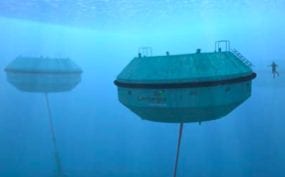This is one of the rare times that being a technology company in Australia is a pretty good place to be. At least compared to project developers.
Perth-based Carnegie Wave Energy has enjoyed a 150 per cent jump in its share price this year – and that’s partly because it has finally begun construction on its first multi-turbine demonstration project near Perth, and being a developer of early-stage technology means that it is not affected by the uncertainty around the future of the renewable energy target, the carbon price, or even the Clean Energy Finance Corp.
As we reported this week, Carnegie has begun earthworks on its three-turbine wave energy project near the naval base on Garden Island, off Fremantle, which will also include a desalination component. But CEO Michael Ottaviano is already looking to the next project, which is to build the next generation CETO-6 modules – which he expects will hit the sweet spot in scale and lead to full-scale production.
 The Garden Island project will feature the CETO-5 generation of modules, which features a buoyant actuator (the thing that moves around with the ocean and drives the pumps) around 20m in diameter (see pic to right). On a commercial-scale, that might deliver electricity at a price that competes with diesel (good for islands like Reunion where Carnegie is developing another project), but not good enough to compete in the mainstream market.
The Garden Island project will feature the CETO-5 generation of modules, which features a buoyant actuator (the thing that moves around with the ocean and drives the pumps) around 20m in diameter (see pic to right). On a commercial-scale, that might deliver electricity at a price that competes with diesel (good for islands like Reunion where Carnegie is developing another project), but not good enough to compete in the mainstream market.
That’s why Ottaviano wants to move to the next stage. The graph below explains why. There is a sweet spot in the size of the buoyant actuator (horizontal axis) and the amount of energy produced (vertical axis).
The CETO-5 is only half way there, so the next project will deploy CETO-6, which will attempt to get as close to maximum output as it can. The exact dimensions are yet to be finalised, but Ottaviano says its output will be at least double the 240kW capacity of the CETO-5 technology. The buoy could be up to 40m wide. Any more, and according to Carnegie’s modelling, it will start to lose efficiency.
Ottaviano says Carnegie is currently looking at options in Australia, the UK and Europe. Inevitably, it will depend on the level of government support. A decision will be made in 2014, for construction to begin in 2015 and production in 2016.
“We want to lock in the funding, the design and the location,” says Ottaviano, who is currently conducting an investment roadshow on the eastern states. “Once we have done that, and brought this into production, then we can go out and sell the product. We’re in the best position we’ve been in for some time.”











